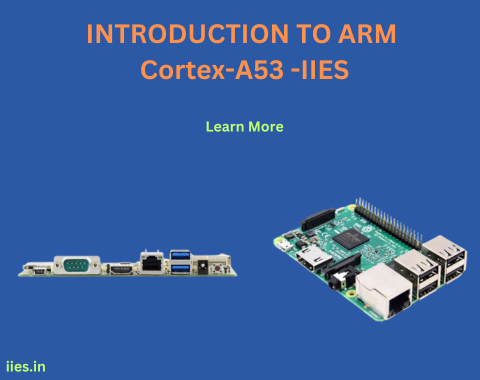
The ARM Cortex-A53 is a 64-bit processor designed by ARM Holdings. It is one of the first two central processing units implementing the ARMv8-A 64-bit instruction set, along with the Cortex-A57 . The Cortex-A53 is a 2-wide decode superscalar processor, capable of dual-issuing some instructions . It is a low-power processor with 64-bit capabilities, applicable in a range of devices requiring high performance in power-constrained environments .
The Cortex-A53 is an 8-stage pipelined processor with a 2-way superscalar, in-order execution pipeline . It has DSP and NEON SIMD extensions that are mandatory per core . The processor has a VFPv4 Floating Point Unit onboard (per core) and hardware virtualization support . It also has TrustZone security extensions, 64-byte cache lines, 10-entry L1 TLB, and 512-entry L2 TLB . The Cortex-A53 has 4 KiB conditional branch predictor, 256-entry indirect branch predictor.
The Cortex-A53 is the most widely used platform for mobile SoCs since 2014 to the present day [as of ], making it one of the longest-running ARM platforms for mobile devices . It is currently featured in most entry-level and lower mid-range SoCs, while higher-end SoCs used the newer ARM Cortex-A55 . The latest SoC still using the Cortex-A53 is the MediaTek Helio G36, which is an entry-level SoC designed for budget smartphones . The ARM Cortex-A53 processor has been used in the LeMaker HiKey since 2015, the Raspberry Pi 3 since February 2016, and the Raspberry Pi Zero 2 W since October 2021 . The Cortex-A53 is also used in a number of Qualcomm, Samsung, and MediaTek SoCs . Semi-custom derivatives of the Cortex-A53 have been used in Qualcomm’s Kryo 250 and Kryo 260 CPUs . The Starlink ground terminals utilize a quad-core Cortex-A53 SoC from STMicroelectronics as its main control unit . The processor is used in the ODROID-C2 and in Roku streaming media players (in the high-end models from 2016 and in all models released between 2017 and 2019) . Another notable Cortex-A53 application is the Pine A64/A64+ single-board computer. These cores are used in a 24-core SoC, the Socionext SynQuacer SC2A11 . The processor is used in Amazon Fire tablets, including the Fire HD 8 and the Fire HD 10 (the latter also includes Cortex-A72 cores) as well as the Nintendo Switch . It is also used in some Amazon Echo Show models such as the Echo Show 5, Echo Show 8, and Echo Show 5 (2nd Gen).
The Cortex-A53 has established itself as the go-to platform for mobile System-on-Chips (SoCs) since the year 2014. It has maintained its dominance as one of the longest-running ARM platforms for mobile devices up until today. While high-end SoCs have embraced the newer ARM Cortex-A55, the Cortex-A53 continues to be the preferred choice for most entry-level and lower mid-range SoCs. One prime example is the MediaTek Helio G36, an entry-level SoC specifically designed for budget smartphones.
Over the years, the ARM Cortex-A53 processor has proven its prowess and reliability by finding its way into a multitude of devices. In 2015, it made its debut in the LeMaker HiKey, followed by its incorporation in the Raspberry Pi 3 in February 2016. More recently, the Raspberry Pi Zero 2 W, released in October 2021, also utilizes this powerful processor.
The Cortex-A53’s popularity is not limited to these well-known devices alone. Major players in the tech industry, such as Qualcomm, Samsung, and MediaTek, have embraced the Cortex-A53, integrating it into their SoC. For instance, Qualcomm’s Kryo 250 and Kryo 260 CPUs are semi-custom derivatives of the Cortex-A53. Additionally, STMicroelectronics has employed a quad-core Cortex-A53 SoC in the Starlink ground terminals, serving as the main control unit.
The Cortex-A53 has also made notable appearances in other devices, leaving its mark in the tech landscape. The ODROID-C2, Roku streaming media players (high-end models since 2016 and all models from 2017 to 2019), Pine A64/A64+ single-board computer, and Socionext SynQuacer SC2A11, a 24-core SoC, have all benefited from the efficient functioning of the Cortex-A53 processor.
The Cortex-A53’s reach extends beyond traditional mobile devices. Amazon Fire tablets, including the Fire HD 8 and Fire HD 10 (which also incorporates Cortex-A72 cores), utilize this processor. It has also found its way into several models of Amazon Echo Show, such as Echo Show 5, Echo Show 8, and Echo Show 5 (2nd Gen). Notably, the Nintendo Switch relies on the Cortex-A53 for its performance. Furthermore, Fortinet’s entry-level firewalls, Fortigate 81F, also utilize this reliable processor.
In conclusion, the Cortex-A53 has undeniably made its mark in the realm of mobile devices and beyond. Its versatile and efficient performance has earned it a well-deserved spot as the preferred platform for many SoCs. Through its widespread adoption and integration into various devices, the Cortex-A53 has solidified its status as a reliable and dominant force in the world of technology.
The ARM Cortex-A53 is a 64-bit processor designed by ARM Holdings. It is one of the first two central processing units implementing the ARMv8-A 64-bit instruction set, along with the Cortex-A57. The Cortex-A53 is a 2-wide decode superscalar processor, capable of dual-issuing some instructions. It is a low-power processor with 64-bit capabilities, applicable in a range of devices requiring high performance in power-constrained environments. The Cortex-A53 is the most widely used platform for mobile SoCs from 2014 to the present day, making it one of the longest-running ARM platforms for mobile devices. It is currently featured in most entry-level and lower mid-range SoCs, while higher-end SoCs use the newer ARM Cortex-A55. The processor is used in a wide range of applications, including smartphones, tablets, single-board computers, and streaming media players.
Indian Institute of Embedded Systems – IIES